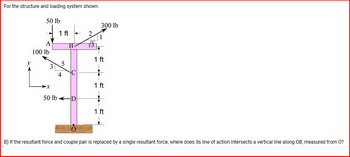
Structural Analysis
6th Edition
ISBN: 9781337630931
Author: KASSIMALI, Aslam.
Publisher: Cengage,
expand_more
expand_more
format_list_bulleted
Concept explainers
Question
For the structure and loading system shown:
B) If the resultant force and couple pair is replaced by a single resultant force, where does its line of action intersects a vertical line along OB, measured from O?

Transcribed Image Text:### Analysis of Forces and Resultant Movements on a Structure
#### Problem Statement:
The image shows a structural system subjected to various loads. The structure consists of two main members, arranged perpendicularly to each other.
#### Description of the Structure:
- **Horizontal Member (AB):**
- Point B has an applied load of 300 lb at an angle of \( \cos^{-1}(\frac{3}{5}) \) from the horizontal.
- Point A has a downward load of 50 lb, positioned 1 ft from point B.
- Point A also has a leftward load of 100 lb.
- The total length between points A and B is 2 ft, with point A located 1 ft from the left end of the horizontal member.
- **Vertical Member (CD):**
- Positioned vertically from point A to a base support at point O.
- Point C has a downward load of 50 lb, located 1 ft from A down to C, with another 50 lb to the left at point O.
- The length from A to C is 3 ft, with sections of 1 ft each from base O and to loading points.
#### Given Task:
B) Determine the location where a single resultant force, replacing the given forces and their moments, intersects a vertical line along the member OB, measured from point O.
#### Graphical Notation and Dimensions:
- **Coordinate Axes:**
- The x-axis is horizontal, and the y-axis is vertical.
- **Spatial Configuration:**
- Points on the structure are labeled as A, B, C, and O with respective distances.
- A rigid base at point O supports the vertical member.
### Steps for Solution (Provided Explanations):
1. **Resultant Force (FR):**
- Sum all the vertical and horizontal forces to find the components of the resultant force \( \vec{F_R} \).
2. **Moment (MR = MO):**
- Calculate the moments caused by the distributed forces about point O to find the total moment \( M_O \).
3. **Line of Action:**
- Determine the point where the resultant force intersects the line OB using the relationship between net force, moments, and distances from point O to give the precise location.
### Conclusion:
This analysis enables the understanding of how complex force interactions can be represented as a single resultant force and moment, simplifying the
Expert Solution
This question has been solved!
Explore an expertly crafted, step-by-step solution for a thorough understanding of key concepts.
Step by stepSolved in 4 steps with 2 images

Knowledge Booster
Learn more about
Need a deep-dive on the concept behind this application? Look no further. Learn more about this topic, civil-engineering and related others by exploring similar questions and additional content below.Similar questions
- For a beam with a cross section of equilateral triangle of side length a= 20 mm, (a) draw the shear and moment diagrams and determine the maximum values of shear and moment throughout the beam. (b) Determine the maximum tensile and compressive bending stresses and the locations they occur. 150 N/m 10 N.m A В C O 00 100 mm 200 mm 300 mm 80 Narrow_forwardThe steel truss shown carries a downward vertical load of 14 kN at joint B. The diagonal members of the truss have an area equivalent to 250 mm^2, and the horizontal members are 300 mm^2. With the given conditions calculate the: a) Horizontal Deflection at E in mm b) Vertical Deflection at D in mm Esteel = 200 GPaarrow_forwardI WOULD LIKE TO KNOW HOW TO SOLVE THESE TWO QUESTIONS IN THE IMAGE ATTACHEDarrow_forward
- A truss is loaded as shown in the figure. Determine the following: a) Vertical component of the resultant force and its location from A. b) Horizontal component of the resultant force and its location from x-axis.arrow_forward1) will upvote anyone who will answerarrow_forwardReplace the loading by an equivalent resultant force and couple moment acting at point 0. Solution Strategy:1. Break the distributed load into “primal” geometric shapes. This problem lends itself to analysis in 3 primal shapes.2. The areas below the load profiles will tell you the magnitudes of the equivalent concentrated loads.3. The position of the individual concentrated loads resulting from breaking up the given load profile will be located at the centroid of each primal.4. Once you have the equivalent concentrated loads and positions for the three primals you can find the resultant force and moment about ? in one of two ways:a. Find a single equivalent force and position (like you did for 11-W) and then relocate this single force to ?? using the techniques from topic 10.b. Use the techniques from topic 10 directly on the three equivalent concentrated loads you found in steps 2 & 3.arrow_forward
arrow_back_ios
arrow_forward_ios
Recommended textbooks for you

 Structural Analysis (10th Edition)Civil EngineeringISBN:9780134610672Author:Russell C. HibbelerPublisher:PEARSON
Structural Analysis (10th Edition)Civil EngineeringISBN:9780134610672Author:Russell C. HibbelerPublisher:PEARSON Principles of Foundation Engineering (MindTap Cou...Civil EngineeringISBN:9781337705028Author:Braja M. Das, Nagaratnam SivakuganPublisher:Cengage Learning
Principles of Foundation Engineering (MindTap Cou...Civil EngineeringISBN:9781337705028Author:Braja M. Das, Nagaratnam SivakuganPublisher:Cengage Learning Fundamentals of Structural AnalysisCivil EngineeringISBN:9780073398006Author:Kenneth M. Leet Emeritus, Chia-Ming Uang, Joel LanningPublisher:McGraw-Hill Education
Fundamentals of Structural AnalysisCivil EngineeringISBN:9780073398006Author:Kenneth M. Leet Emeritus, Chia-Ming Uang, Joel LanningPublisher:McGraw-Hill Education
 Traffic and Highway EngineeringCivil EngineeringISBN:9781305156241Author:Garber, Nicholas J.Publisher:Cengage Learning
Traffic and Highway EngineeringCivil EngineeringISBN:9781305156241Author:Garber, Nicholas J.Publisher:Cengage Learning


Structural Analysis (10th Edition)
Civil Engineering
ISBN:9780134610672
Author:Russell C. Hibbeler
Publisher:PEARSON

Principles of Foundation Engineering (MindTap Cou...
Civil Engineering
ISBN:9781337705028
Author:Braja M. Das, Nagaratnam Sivakugan
Publisher:Cengage Learning

Fundamentals of Structural Analysis
Civil Engineering
ISBN:9780073398006
Author:Kenneth M. Leet Emeritus, Chia-Ming Uang, Joel Lanning
Publisher:McGraw-Hill Education


Traffic and Highway Engineering
Civil Engineering
ISBN:9781305156241
Author:Garber, Nicholas J.
Publisher:Cengage Learning